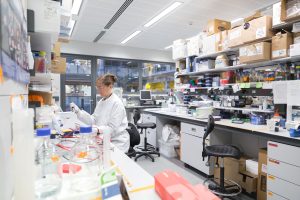One of the fun things I have to do in my job is find ways to increase collaborative research between IMSE and commercial companies. This is complicated. Research is risky, it’s expensive, it’s built on constantly generating new ideas, and this only happens with the right mix of the right people. How can we make all of this happen? One of the ways is with big collaborative research projects which are part-funded by industry and partly by public investment. In this post, I look at how this works.
Partnerships to share innovation risk
The UK university sector is world-class and does world-class research. However, compared to other advanced economies, UK investment in R&D is relatively low.
Private business investment accounts for about half of the R&D spend in the UK. There’s a gorgeous interactive graphic on the ONS site which shows flows of research and development funding in the UK in 2019.
Most business R&D spend happens within businesses, with only a small part of UK business R&D spend going to universities. Instead these receive a good deal of investment from businesses outside the UK.
It makes sense for commercial companies to outsource research to a university. Research is a risky business and it requires serious investment in labs and people with specialist skills. Since the 1980s, companies have been reducing the quantity of science research they carry out in-house, as this reduces risk to the company. Universities are specialist innovator organisations and can do this instead. But it makes it harder/slower to transfer this knowledge into products that can be sold and used.
UK universities now usually have whole departments dedicated to building and managing collaborative research projects and programmes with industry. Here’s an example: Imperial’s Industry Partnerships and Commercialisation team.

Partnerships to generate innovation ideas
Industry come up with research questions that are different from the ones that academics come up with. This is not an ivory tower thing, where academics are off chasing improbable theoretical knowledge with little application, whereas industry is actually solving real problems. That’s a caricature which has never been true, especially in engineering. This is extra specially true for Imperial College London, whose precursor organisations were hospitals and technical colleges.
It’s just that research questions pop up whenever you try to do some science, and they differ depending on the kind of question that you’re asking. Here‘s an example:
Suppose Sam a biochemist working in a university. He has developed a new pesticide compound. He’s not interested in working this up into a product that can be used, but instead wants to understand the fundamental properties and behaviour of this kind of molecule. However, a commercial company he partners with is very interested creating a product out of this pesticide. So they get a formulations chemist Kim to work on it.
Kim starts combining the active ingredient with other excipients, things like preservative, antifreeze, etc. She notices that the compound reacts with a viscosity additive in the presence of UV light. This excludes the additive from use in a real product, and the reaction is of no further interest to her or the company. But to Sam, this is fascinating chemical behaviour, which he might never have discovered because he never needed to do the experiment that found it. So he does some more experiments into the light-activated behaviour of the pesticide …. And the cycle continues.
This one’s fictional, but you get the idea! You’ll never know the answer to the question that you’re not asking.

Partnerships at a national scale
Working with industry a core of the strategy of UKRI, the UK’s national research and innovation funding body. At the moment, IMSE and many other groups at Imperial are preparing collaborative research proposals to the Engineering and Physical Sciences Research Council (ESPRC, part of UKRI) for Centres of Doctoral Training. These centres train groups of PhDs to meet a national industry need. Under this funding call, the ESPRC expect that universities will fund no more than 50-60% of the total cost of these centres. You see how industry support is built into the whole plan?
Developing these collaborative research proposals relies on academics being well networked with researchers who work for commercial organisations. Last week IMSE held a co-creation workshop with representatives of companies we already work with and know well. The topic for the CDT we’re working on is in formulation science – developing the products we use everyday, like detergents, pharmaceuticals, agrochemicals, and pharmaceuticals. All of these are complex mixtures of active and carrier ingredients, and take some considerable R&D in their own right in addition to developing the active ingredients in the first place.
Partnerships to innovate training
We asked industry: what do you need your new PhD hires to be able to do? What do they usually not know when they graduate, that you would like them to know? Of course this resulted in a long list of desired skills…
- Technical skills for formulations included colloid science.
- Sectoral skills reflect the big trends in manufacturing at the moment, such as automated design of experiments, or understanding the environmental impact of processes and products.
- Transferrable skills included managing a research project to deliver a business objective, or how to make decisions when you have incomplete data and high uncertainty.
Because the CDTs are a national initiative, many research groups up and down the country will be asking their industrial colleagues these questions at the moment. This is how the next generation of innovators are being trained.

What do you think of this? Do you think this is the right way to go about it? Are these kinds of collaboration a good thing? What sort of proportion of national R&D spend do you think should be privately vs publicly sourced?
Read about how IMSE are training part of the next generation of scientists.